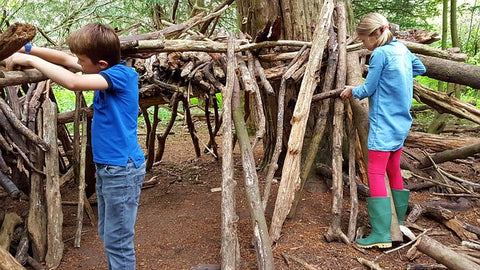American children aged 8-12 spend between four and six hours a day on average looking at screens. Among teens, this rises to nine hours a day. That much screen time runs the risk of exposing children to unsuitable content such as violence and sexuality, robbing them of their childhood innocence. But it also has real health implications too.
According to the American Academy of Child and Adolescent Psychiatry, too much screen time can lead to sleep problems, Lower grades in school, not enough outdoor or physical activity leading to weight problems, mood problems, poor self-image and body image issues and more.
One of the best things you can do as a parent is help your children put down those screens and instead find other forms of entertainment during leisure time. Not only is it great for children’s health to be active, especially outdoors, but it can help bring you closer as a family too.
Here are ten time-honored activities for you to try this weekend:
1. Hopscotch. Use a piece of chalk to draw the hopscotch board: the numbers one to ten laid out in boxes stacked on top of each other. Each player takes it in turn to throw a stone onto the board, hop up the board, landing on each number, to retrieve the stone, and then hop back. While you have the chalks out, why not also use them to create sidewalk art?

2. Tiddlywinks. A firm favorite for rainy days. This classic English Victorian parlor game involves using a ‘squidger’ to make the ‘winks’ — small round plastic disks — jump into the air. The aim is to get them to land in a pot placed in the center of the board or table.
3. Pooh sticks. Take a trip to the 100 Acre Forest with this game made famous by the classic children’s books. The rules are very simple: first, find a bridge over a stream or river to play on, ideally located within woodland. Everyone then finds a small stick, lines up on the upstream side of the bridge, and on the count of three, drops their stick into the river. They all then rush to the other side of the bridge, and the first stick to emerge from under the bridge is the winner.
4. Kite making / flying. Is there a better way to spend a windy day than making your kite dance through the sky and loop the loop all afternoon? Well, yes – flying a kite that you made yourself that morning. You can make a simple diamond kite using nothing more than two sturdy sticks, a plastic bag or some fabric, string, and glue. Don’t forget to decorate the sail before you attach it to the sticks, and give your kite a colorful tail.

5. Fort / den building. There’s nothing more magical in childhood than creating your own cozy den and using it as a hideout. In winter, under the stairs or in the corner of a bedroom is the ideal location. In summer, cover branches with canvas and leaves to make a secluded hideaway. Decorate with lights and bunting, and if your children are feeling brave enough they can even camp out, toasting s’mores around a campfire (with adult supervision of course), before turning in for the night.
6. Marco Polo. This variation on Tag takes its name from the 13th Century Venetian merchant and explorer who traveled the Silk Road to Asia. In the modern game, one player is blindfolded, and tries to catch the others. When they shout ‘Marco’ the others must reply ‘Polo’, giving away their whereabouts.
7. Rockpooling / shell collecting. Who can resist a trip to the seaside on a sunny day, no matter what the season? Rockpools have fascinated children for centuries as there’s always so much life to be found within those small tidal ponds. Pick up a book listing common species and try to identify your finds without resorting to Google. As the day draws to a close, take a stroll along the beach to collect colorful shells to be used in art projects at home.

8. Tie dying. Brighten up a plain t-shirt by scrunching or twisting it up, tying an elastic band around it, and immersing it in dye. Why not forage for plants that can be used as natural dyes growing near you or even in your garden?
9. Jacks. Jacks is one of the oldest games on the planet, dating back to prehistoric times. The Romans who drew lots to gamble for Jesus’s robe at the crucifixion likely used a version of this game to do so. Over the centuries, various objects have been used as the jacks, including stones, seeds, and even knucklebones from goats. Consequently, there are endless variations on how Jacks can be played, but the most popular in America is to throw a ball into the air, and to pick up first one jack before the ball bounces, then two, then three and so on.
10. Reading. As John Adams often said to his son John Quincy, “You will never be alone with a poet in your pocket.” Books open doorways into whole new worlds, transporting the reader across thousand of miles to centuries past or yet to come. Reading is also an excellent way to improve concentration, which is so often badly eroded by screens and social media. You can find out more about reading out loud with children in our blog series on the subject. If you’re looking for new books to read, why not start with Heroes of Liberty?






